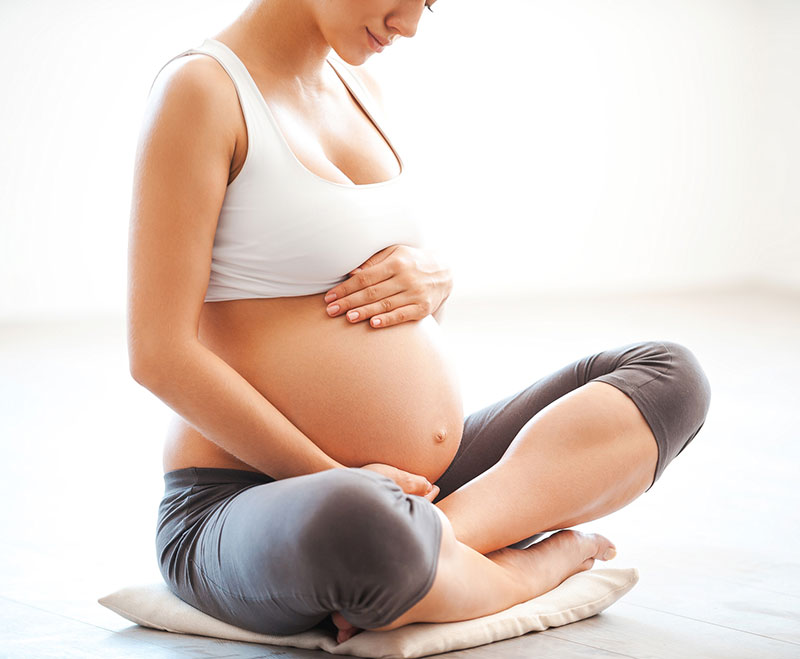Back
The Benefits of Pelvic Floor Physical Therapy During Pregnancy
By Dr. Zarina Vitebsky, DPT, MSPT, PRPC, TPS, LPF, DN on 1/16/2023

Here’s the truth about pregnancy, childbirth, your pelvic floor, and pelvic floor physical therapy.
Pregnancy and childbirth can bring about some major physical changes. The focus is often on external ones, like a growing belly. But one of the biggest pregnancy and childbirth changes impacts an area that’s impossible to see from the outside: the pelvic floor. We won’t lie to you, pregnancy and childbirth can definitely do a number on this area. But for some people, a little thing called pelvic floor physical therapy may be able to help.
The “pelvic floor” is a group of muscles that are housed inside your pelvis. It forms a basin-like structure that spans from your tailbone to your pubic bone. Together they form a sling of muscles that provide support and help stabilize EVERYTHING above, including your bladder, uterus, rectum/bowels & all your abdominal cavity contents. The muscles themselves work like any other skeletal muscle in the body (think biceps) - they contract to help hold in urine/stool/gas and relax to help empty bladder/bowel. They are also a critical player in “core stability,” so they help to stabilize our body against outside forces.
Most women don’t think about their pelvic floor until after they’ve had a baby or two and are having trouble with urine leakage. But waiting until after your baby is born is not the right time to start thinking about the health of your pelvic floor. You use your pelvic floor muscles during urination and vaginal intercourse. You also use these muscles during childbirth. The pelvic floor is designed to stretch under pressure and bounce back to provide continued support. It’s important to keep yours as healthy as possible before, during, and after pregnancy. Starting out your pregnancy with strong pelvic floor muscles helps decrease the damage these muscles experience under the strain of carrying a growing child.
Pelvic floor physical therapy during pregnancy can help prepare you for giving birth. It’s recommended that you begin pelvic floor physiotherapy anywhere between the second and third trimester. Pelvic floor treatment can help ensure the muscles are elastic enough for birth.
It can also act as a preventive measure. For example, incontinence is common during pregnancy. But if you’re leaking all the time, then perhaps there’s a problem with muscle integrity. Maybe the muscles aren’t strong enough to hold and control the bladder. That’s something that a patient can work on during pregnancy.
A healthy pelvic floor also makes labor and delivery less risky, as you’ll be better equipped for labor, which means less stress for your baby. To sum it up: “You have a giant head going through a small vagina,” Of course, the rest of the baby’s body passes through too. But, typically, the head will go first. In the process, pelvic floor muscles get shoved out of the way and sometimes tear. There may also be damage to the nerves that govern pelvic floor muscles and organs.
How does a C-section affect the pelvic floor?
Many people think that although they had a cesarean birth, their pelvic floors have been spared the “trauma” that might have occurred with a vaginal delivery. Unfortunately, this is not true! Although a baby did not travel through the birth canal, the pelvic floor muscles and the pelvic ligaments were under the same amount of pressure over the previous 9 months of pregnancy. A woman’s posture still changes in the same fashion to adapt to a growing baby, and unfortunately, women are at risk of experiencing the same difficulties postpartum as a woman who had a vaginal birth.
What are the most common reasons a pregnant woman would see us during pregnancy?
Bowel or Bladder leakage (with sneezing, coughing, or exercise)
Pain or discomfort in the low back, hips, pelvic bone, or vagina
Ensure she is doing kegel exercises properly (50% of people do them incorrectly!)
Persistent abdominal bulging
Vaginal, perineal, or rectal pressure or bulging sensation
Help a woman get ready physically for labour and delivery, including teaching you how to relax the pelvic floor, how to “push” without over-straining the pelvic floor, and teaching perineal stretching.
We specialize in pelvic floor disorders. Pelvic Floor physical therapy is a way of trying to strengthen the area to alleviate symptoms under the guidance of a physical therapist at Pelvic Health NJ. Just like you’d go to physical therapy if you tore your ACL, you might consider seeing us who is trained in techniques that research suggests it helps rehab your pelvic floor.
At Pelvic Health NJ, we teach you how to properly do Kegels (relaxing and tightening the pelvic floor muscles), go over proper posture so the pelvic floor muscles might work in a more coordinated fashion with the rest of the body, teach deep breathing work that attempts to stimulate the pelvic floor, and more. If we think you could benefit from a stronger pelvic floor, we will come up with a game plan to possibly help you retrain those muscles to contract and loosen appropriately. Then, you will typically start regular appointments to work on your pelvic floor muscles while the the therapists at Pelvic Health NJ track your progress.
“Like any muscle in the body, retraining the pelvic floor muscles takes time, but is often very successful.”
Please contact us at contact@pelvichealthnj.com or call 908-443-9880 to schedule a consultation.
Read More:
How Chronic Pelvic Congestion in Men Contributes to Prostatitis By Shannon Strauch, PTA, STMT-1 on 12/11/2024 How lymphatic issues can cause symptoms of prostatitis Prostatitis and Tight Pelvic Floor Muscles: A Comprehensive Guide By Shannon Strauch, PTA, STMT-1 on 12/10/2024 How a tight pelvic floor can be the reason for prostatitis symptoms
Are you ready to live pain free?
Request An Appointment